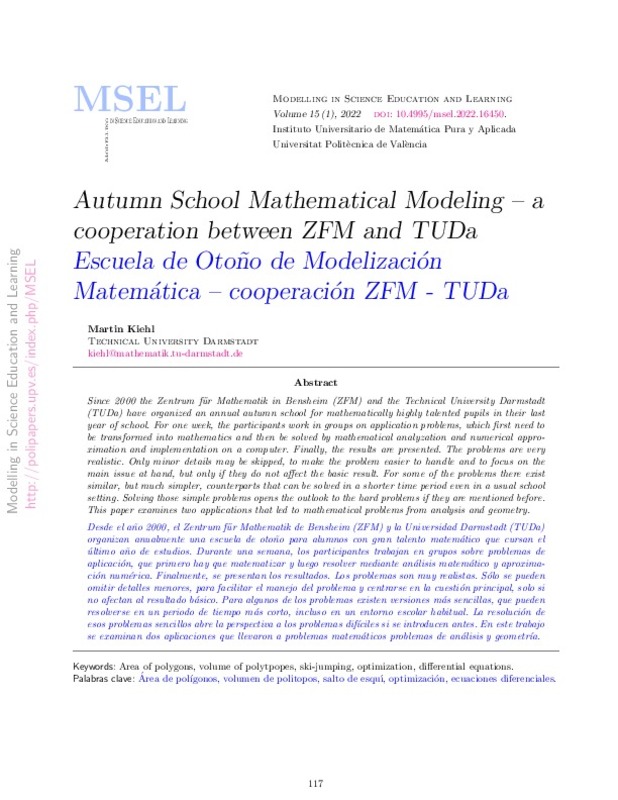JavaScript is disabled for your browser. Some features of this site may not work without it.
Buscar en RiuNet
Listar
Mi cuenta
Estadísticas
Ayuda RiuNet
Admin. UPV
Autumn School Mathematical Modeling – a cooperation between ZFM and TUDa
Mostrar el registro sencillo del ítem
Ficheros en el ítem
| dc.contributor.author | Kiehl, Martin
|
es_ES |
| dc.date.accessioned | 2022-02-01T09:01:43Z | |
| dc.date.available | 2022-02-01T09:01:43Z | |
| dc.date.issued | 2022-01-29 | |
| dc.identifier.uri | http://hdl.handle.net/10251/180408 | |
| dc.description.abstract | [EN] Since 2000 the Zentrum f¨ur Mathematik in Bensheim (ZFM) and the Technical University Darmstadt (TUDa) have organized an annual autumn school for mathematically highly talented pupils in their last year of school. For one week, the participants work in groups on application problems, which first need to be transformed into mathematics and then be solved by mathematical analyzation and numerical approximation and implementation on a computer. Finally, the results are presented. The problems are very realistic. Only minor details may be skipped, to make the problem easier to handle and to focus on the main issue at hand, but only if they do not affect the basic result. For some of the problems there exist similar, but much simpler, counterparts that can be solved in a shorter time period even in a usual school setting. Solving those simple problems opens the outlook to the hard problems if they are mentioned before. This paper examines two applications that led to mathematical problems from analysis and geometry. | es_ES |
| dc.description.abstract | [ES] Desde el año 2000, el Zentrum für Mathematik de Bensheim (ZFM) y la Universidad Darmstadt (TUDa) organizan anualmente una escuela de otoño para alumnos con gran talento matemático que cursan el último año de estudios. Durante una semana, los participantes trabajan en grupos sobre problemas de aplicación, que primero hay que matematizar y luego resolver mediante análisis matemático y aproximación numérica. Finalmente, se presentan los resultados. Los problemas son muy realistas. Sólo se pueden omitir detalles menores, para facilitar el manejo del problema y centrarse en la cuestión principal, solo si no afectan al resultado básico. Para algunos de los problemas existen versiones más sencillas, que pueden resolverse en un periodo de tiempo más corto, incluso en un entorno escolar habitual. La resolución de esos problemas sencillos abre la perspectiva a los problemas difíciles si se introducen antes. En este trabajo se examinan dos aplicaciones que llevaron a problemas matemáticos problemas de análisis y geometría. | es_ES |
| dc.description.sponsorship | Technical University of Darmstadt | es_ES |
| dc.language | Inglés | es_ES |
| dc.publisher | Universitat Politècnica de València | es_ES |
| dc.relation.ispartof | Modelling in Science Education and Learning | es_ES |
| dc.rights | Reconocimiento - No comercial (by-nc) | es_ES |
| dc.subject | Area of polygons | es_ES |
| dc.subject | Volume of polytpopes | es_ES |
| dc.subject | Ski-jumping | es_ES |
| dc.subject | Optimization | es_ES |
| dc.subject | Differential equations | es_ES |
| dc.subject | Area de polígonos | es_ES |
| dc.subject | Volumen de politopos | es_ES |
| dc.subject | Salto de esquí | es_ES |
| dc.subject | Optimización | es_ES |
| dc.subject | Ecuaciones diferenciales | es_ES |
| dc.title | Autumn School Mathematical Modeling – a cooperation between ZFM and TUDa | es_ES |
| dc.title.alternative | Escuela de Otoño de Modelización Matemática – cooperación ZFM - TUDa | es_ES |
| dc.type | Artículo | es_ES |
| dc.identifier.doi | 10.4995/msel.2022.16450 | |
| dc.rights.accessRights | Abierto | es_ES |
| dc.description.bibliographicCitation | Kiehl, M. (2022). Autumn School Mathematical Modeling – a cooperation between ZFM and TUDa. Modelling in Science Education and Learning. 15(1):117-136. https://doi.org/10.4995/msel.2022.16450 | es_ES |
| dc.description.accrualMethod | OJS | es_ES |
| dc.relation.publisherversion | https://doi.org/10.4995/msel.2022.16450 | es_ES |
| dc.description.upvformatpinicio | 117 | es_ES |
| dc.description.upvformatpfin | 136 | es_ES |
| dc.type.version | info:eu-repo/semantics/publishedVersion | es_ES |
| dc.description.volume | 15 | es_ES |
| dc.description.issue | 1 | es_ES |
| dc.identifier.eissn | 1988-3145 | |
| dc.relation.pasarela | OJS\16450 | es_ES |
| dc.description.references | Hans - H Gasser (2008). Grundlagen der Auslegung des Längsprofils einer Skisprungschanze. Technical report, Fédération Internationale de Ski (FIS). | es_ES |
| dc.description.references | Immanuel Kant (1786). Metaphysische Anfangsgr¨unde der Naturwissenschaft-Vorrede Neuauflage. In: Meiner, Philosophische Bibliothek, Vol 508. Konstantin Pollok (Ed.) Meiner. | es_ES |
| dc.description.references | Audi. https://www.youtube.com/watch?v=a9-hulXu4Ys (accessed: 2021.07.05). | es_ES |
| dc.description.references | wiev1. https://wiev1.orf.at/stories/144294 (accessed: 2021.07.05). | es_ES |








